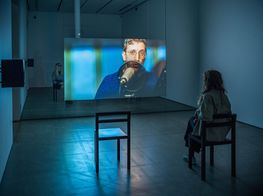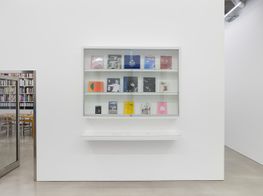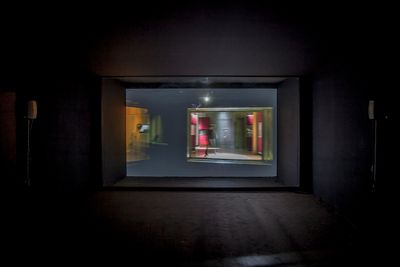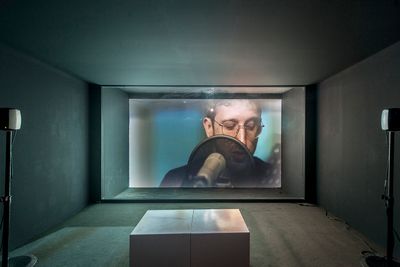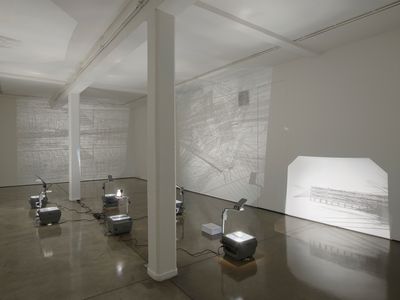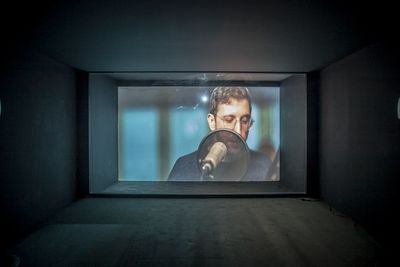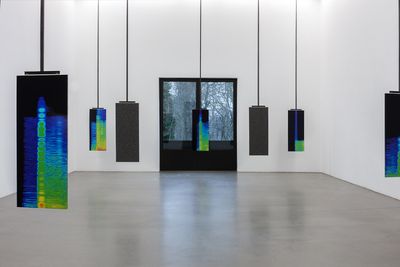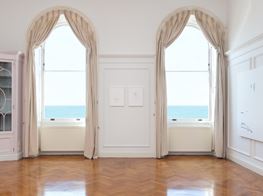Lawrence Abu Hamdan
Lawrence Abu Hamdan. Courtesy Maureen Paley. Photo: Eric T. White.
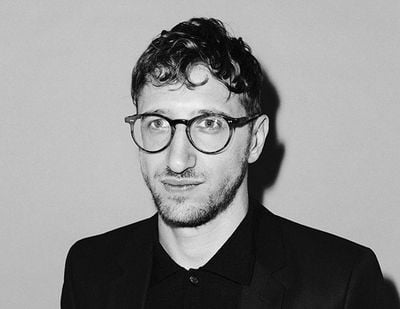
Lawrence Abu Hamdan. Courtesy Maureen Paley. Photo: Eric T. White.
Contemporary art seldom deals with the significance of sound in the sphere of human interaction—the tradition of prioritising images over other sensory information continues to define our perception of the world. The work of Lawrence Abu Hamdan challenges viewers to re-evaluate this image-centred paradigm by offering a different set of methodologies that consider what is often taken for granted around us, taking into account the sounds that define the contexts in which crimes and a disregard for the law take place.
A self-defined 'Private Ear', Abu Hamdan's work transcends the lines separating the role of an artist from that of a political actor by amplifying the aesthetics of sound in contemporary art discourse and establishing a new emphasis on listening. His audio investigations—conducted as part of his research for Forensic Architecture at Goldsmiths, University of London, where he received his PhD in 2017—have been used as evidence at the UK Asylum and Immigration Tribunal and as advocacy for other NGOs. In 2016, Abu Hamdan worked with Amnesty International and Forensic Architecture to produce an acoustic investigation into the government-controlled Saydnaya prison in Syria, where 13,000 people have allegedly been executed since the protests in 2011 began. Likewise, his 2016 film Rubber Coated Steel documents the investigation that the artist conducted with Defence for Children International and Forensic Architecture, for which he examined the audio recordings of the shots that killed teenagers Nadeem Nawara and Mohammad Abu Daher in the West Bank of Palestine. The resulting film was awarded the short film award at the Rotterdam International Film Festival in 2017.
Abu Hamdan has received a number of prestigious awards in recognition of his work, with his exhibition Earshot at Portikus Frankfurt (13 February–10 April 2016) awarded the Nam June Paik Award in 2016. Most recently, he was awarded the 2018 Abraaj Group Art Prize, for which he presented his prize-winning commission, Walled Unwalled (2018), at the 2018 edition of Art Dubai: a single-channel film projected onto a glass wall covered in holographic foil, which the artist discusses in detail in this conversation. The film was shot in a former GDR radio station, making reference to East German radio production and the output of American Radio Free Europe in West Germany, which sought to counter East German propaganda. The narrative is constructed out of a series of interlocking stories based on recent legal cases that used evidence based on what was heard or experienced through walls, including the story of a man in Oregon who was caught growing hydroponic marijuana with new heat-sensing police technologies, and the case of South African sprint runner Oscar Pistorius, who was convicted of murdering Reeva Steenkamp through testimonies and investigations involving audio forensics. The work considers how new technologies are enabling those with political power to rearrange the distinctions between inside and outside, private and public.
MSI'd like to discuss your practice in consideration of what the philosopher Wilfrid Sellars has identified in terms of the difference between the 'manifest' and 'scientific' image of the world. For Sellars, the former is the immediate image that is delivered to humans through pure sense perception, whereas arriving at the scientific image requires the invention of models and instruments that can make observations beyond the capability of our senses. The final scientific image is a sort of collage made of different observations, producing a more complex image of the world.
Does this resonate with you?
LAHOn the one hand, yes. There's the question of the perceivable and then there's the question of science stepping in either at the very threshold of perception or at things that are impossible to see or observe. What's interesting for me is not a translation between sound and image, but a sound-image, and I think where the role of the artist comes in is really like that of a scientist.
My favourite artists are those who observe things that are not necessarily outside the realm of perception, but are outside the frames in which they should be considered perceivable. That means light switches, for example, or the way that a shadow falls under the curtain—very romantic ideas of what an artist looks for that is really at the edge of what is considered relevant. From that frame, one can also start to build investigative strategies by which science meets the ways that artists observe the world.
It's not a coincidence that in Antonioni's film Blowup (1966) and Brian De Palma's Blow Out (1981), it is the artists—a photographer and sound effects technician respectively—who turn into murder investigators. That's because they are trained to see at the very threshold of images or sound, listening so intently to the world that things emerge that are perhaps at the edge of what's perceivable. I'm interested in this procedure as a continuation of an artist's project—an investigative strategy that I see, at its core, as an aesthetic practice.
MSIn a sense, your work is about taking information and re-evaluating it in order to make truth claims; you reveal something new about the world and reflect it back to the audience. But you're not just an unbiased, neutral actor, even if your work takes a journalistic or evidentiary approach. Do you see yourself as a creator of intelligent propaganda?
LAHI despise anyone who says that art is about asking questions, and not providing answers. You hear that pretty much every day in our profession. Artists who repeat this statement think of this as a radical act. But what if art's radicality is actually about art being an engine for truth production? I'm not talking about the same forms of truth production in science or law, since science is totally different to law and each represents two different models for telling the truth. In forensics, science and law meet in some weird space. In art, you can borrow from the ways that science and law tell the truth in order to come up with the means by which art can also speak it.
There are ways that truth claims, which are expressed or made differently to how the law or science delineate the truth, can be folded into the production of an artwork. And that's a very important distinction to make, especially because law and science draw outlines around their objects. For example, law says: 'This here is a millimetre-thin wood veneer that covers this cupboard as an object that is separated from the world in which it's surrounded.' Whereas I think that an artistic process of telling the truth is the opposite: it's about blurring the line between the veneer, the door, the space and its reflections, taking into account its sound and all the other phenomena around it. This way of working is the extension of the way artists approach their work as a spatial and environmental practice; so that a video artist knows the electricity cable going to the screen is an important part of the work, or a painter knows the light conditions of the room are an element of the work. We are trained in this environmental way of thinking.
MSYour film Walled Unwalled weaves together investigative narratives narrated by yourself. What necessitated you to physically put yourself at the centre of this project?
LAHI often use my own voice in my works, and often the works are about voice. An example of this is Saydnaya (the missing 19db) (2017), which is about the level at which detainees of Saydnaya prison in Syria could whisper, which was 19 decibels lower than a previous generation of inmates. It necessitated a kind of voiceover that was extremely voracious in the classic sense, very BBC. Why? Because essentially, I am making a truth claim that surrounds a whisper in which there is no material trace of the prison, except for the effect that the prison's regime of silence had on the vocal chords of those inside it. So how do you make an argument or a claim for this thing that is as fragile as a whisper? How do you meet that, and find the contradictions in listening and the ways in which truths are made and heard, by counterpointing something as fragile as a whisper with an authoritative voice? A classic BBC voice made sense as a counterpoint, as a strange thing that you're struck by and forced to calculate in relation to a whisper.
Walled Unwalled is slightly different. I don't have a perfect answer for why, but in this work I would say that it's really because I was trying to capture what I do in my live work—my video essays and lectures—into a film, not unlike a documentary, in the same way that Spalding Grey made his works into film, or had directors make his monologues into films. Grey had this amazing way of meeting this personal experience. For example, in Swimming to Cambodia (1987), he talks about his experience of playing the part in the film that is about the Khmer Rouge massacres. There are these instances of humour where he's high on a beach, and it's funny until it's not and he builds on these moments so that they suddenly collapse into this other space and time, and other world. Through his presence—both in terms of being there on location and right here in front of the camera—the only way you could build these intensities and drop them out and make things totally absurd is to over-perform them yourself, and to really, and ridiculously, be there.
These elements are almost stupid gestures, but in Walled Unwalled I think they work well because the whole space that I wrote the performance for is very diagrammatic and stripped down to its simple forms. The walls contract, expand, and turn to make different surfaces—the floor can sound like snow, wood, marble. The technologies are very analogue, blatant or obvious, and I think there's something nice about me standing there doing things that you never see but only hear from a removed voice in a voiceover situation.
In my live work, I usually take ideas that I am developing into works, before they become works, and start to play with them live, working and manipulating my own voice. Because so much of the work is about listening, I think being able to control that and to think about how you are being heard and how you want to be heard is an essential process by which you can start to understand these things and make them vulnerable or raw, because you're already dealing with how you want to be heard. I think that means that you are in a position where you are forced to consider the politics; the burden of proof falls onto the investigator and not on the victims.
MSThere are two stories in Walled Unwalled that are very crucial to the piece. You connect Radio Free Europe to a GDR radio station, whose propaganda Radio Free Europe was created to counter. By occupying a space of propaganda, you are producing truth claims, and for this we need your presence there as the sahed, the Arabic and Farsi word for witness.
LAHI think you're right. If you're going to make propaganda then don't hide it, own it. Like I said before, I'm trying to be a model of an artist—I'm also playing the character of the private investigator.
MSThe title Walled Unwalled encapsulates the narratives that constitute the piece, and how sound is being surveilled and used to solve each case you describe in it. How do you see this? To me, it has some relation to Foucault's concept of the panopticon, which represents this kind of centralised surveillance system. It's as if you are addressing a major shift in the condition of the panopticon, whereby the panopticon is not falling apart because we're being watched more.
LAHYes, though I don't think the panopticon is the way to talk about surveillance. In a way, you could say this film is about the postmodern internet. It seems that it's about walls, or architecture, or our relationship to space, but actually it's about data; it's about the smartphone screen and how that, in a way, has become another kind of wall. It's about access and control and the trap of transparency, which is why Reagan's in there. There's a glass wall installed in front of the film, so that you're not actually in the room where the film is being projected—the glass wall divides you, and you can only see the film through the glass wall that's transparent, but nevertheless impenetrably solid.
MSBy putting a sheet of holographic foil over the glass between the projection and the audience, you really break out of the flatness of screen. This luminous materiality extends from the projected surface of the film to the surface of glass, occupying the thick three-dimensional space between the two.
LAHThat's exactly what I wanted to do: to speak about the thickness of walls. If we speak about the flatness of walls then we're back in this kind of classic sense of how we understand boundaries—as a kind of legal line, as a jurisdiction, as a nation. Some of the film involves beautiful, brilliant accidents—because we're projecting on two layers of glass that are at angles, which creates this crazy sense of depth, where you have no idea where the focus is. There's also the noise and distortion of the glass and what that does to the image, which is why I created it for that space.
I was interested in how this illustrates a sort of freedom or transparency trap; but walls are also the perfect devices for fiction because they are more conceptual than they are physical, especially now. There is an echo of the Cold War, in the sense that the iron curtain was the biggest divide, yet the biggest threat was nuclear, which no wall could withstand. So what is the fiction of that wall, when what's actually on the table is a bomb that erases walls and does not even follow the logic of walls? It just erases boundaries.
MSYou are right to mention the Cold War. Today, there's no Berlin Wall, and yet the historical divisions that the wall represented are ever more present between the superpowers today.
LAHOn another basic level, there's more access than ever before but we are falling deeper and deeper into tribal and identitarian structures. What is this weird paradox that the self is trying to push against, when actually it's trying its best to find the border and each time it hits this boundary it bleeds onto another one? In Walled Unwalled, I'm after the condition that is depicted through the stories that are heard or experienced through walls: most explicitly through digital walls, or in terms of surveillance, when the film or camera is used to see, particularly in the context of a prison. A prison is the most extreme example of an architecture that tries to both confine and expose people at the same time, and this is why, as I said before, the panopticon isn't the way we should talk about surveillance.
I think a good model to talk about surveillance today is John Cage's silent 1952 work 4:33, where there's no performer on stage and there's no spotlight on one person. It's a mass, a collective, a cough, a rustle in the chair; it's the audience as performer, and as a kind of meta-data. I think one of the major problems with why the issue of surveillance has not connected with people is because they were so ready on a public level to discuss the panopticon, or George Orwell, and I don't think these are perfect strategies to think about surveillance now. We should engage with radical practices of listening that were established in the seventies, mostly through experimental music, film and avantgarde art, and understand how they have led to current conditions of eavesdropping.—[O]

